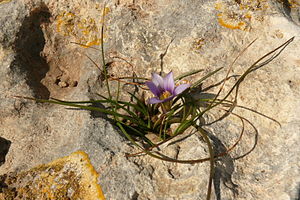Romulea columnae
| Romulea columnae | ||||||||||||
|---|---|---|---|---|---|---|---|---|---|---|---|---|

Romulea columnae in Malta |
||||||||||||
| Systematics | ||||||||||||
|
||||||||||||
| Scientific name | ||||||||||||
| Romulea columnae | ||||||||||||
| Sebast. & Mauri |
Romulea columnae is a plant from the family of the Iridaceae (Iridaceae). It is native to the Mediterranean area.
description
Romulea columnae is an herbaceous plant that reaches a height of 2 to 15 centimeters. The egg-shaped to almost spherical tuber is 1 to 1.5 centimeters long and surrounded by a brown outer skin that breaks off towards the top. The leaves are semi-cylindrical, firm and upright or spread around the plant.
The inflorescence, which is initially 4 to 6 centimeters long but lengthening later, is usually one, rarely two to three-flowered. The lower bract is completely herbaceous, the upper up to the central rib membranous. The perigone measures 10 to 12 millimeters, the tube measures a third of the entire bracts . The throat is hairless and provided with a yellow throat spot, the free end of the bracts is yellow or purple with darker markings, at the outer end pointed to blunt. The stamens are half as long as the inflorescence, the stylus does not protrude beyond the stamens.
The number of chromosomes is 2n = 60.
Occurrence
The species is common around the Mediterranean Sea and in parts of Western Europe. The stenöke species colonizes cattle pastures, bushes and clearings, but also dry rocks at altitudes from 0 to 1200 meters.
Systematics and botanical history
The species was first described in 1818, the species name honors the Italian botanist Fabio Colonna . Depending on the author, a distinction is made between different sub-taxa, the type is considered to be insufficiently processed. For example, Romulea ramiflora , Romulea melitensis and Romulea rollii can be found as varieties of Romulea columnae or Romulea assumptionis is understood as a subspecies, other works, however, understand each of the taxa as an independent species. Here the Flora Europaea is followed, according to which only Romulea rollii is understood as a subspecies of Romulea columnae :
- Romulea columnae subsp. rollii (Parl.) Marais : The leaves are thread-like, 15 to 25 cm long, not stiff or firm. It occurs on the coast from southern France to Turkey and in North Africa.
- Romulea columnae subsp. columnae : The leaves are thicker, shorter and stiffer. It occurs from Western Europe to the Mediterranean and Macaronesia.
But there is also:
- Romulea columnae subsp. assumptionis (Font Quer) O.Bolòs, Vigo, Masalles & Ninot (Syn .: Romulea assumptionis Font Quer ): It occurs on the Balearic Islands and on the Îles d'Hyères .
And outside of Europe:
- Canary pseudo crocus ( Romulea columnae subsp. Grandiscapa (Webb) G.Kunkel , Syn .: Romulea grandiscapa Baker ): It occurs in Macaronesia .
Individual evidence
- ↑ a b c d e f Sandro Pignatti (ed.): Flora d'Italia . Vol. 3. Edagricole, Bologna 2003, ISBN 88-506-2449-2 , pp. 426 (third unaltered reprint of the 1st edition from 1982).
- ^ A b c d S. M. Haslam, PD Sell, PA Wolseley: A Flora of the Maltese Islands. Msida (Malta), 1977.
- ^ A b Hans Christian Weber, Bernd Kendzior: Flora of the Maltese Islands - A Field Guide. Margraf, Weikersheim 2006, ISBN 3-8236-1478-9 .
- ^ W. Marais: Romulea. In: TG Tutin, VH Heywood, NA Burges, DM Moore, DH Valentine, SM Walters, DA Webb (eds.): Flora Europaea . Volume 5: Alismataceae to Orchidaceae (Monocotyledones) . Cambridge University Press, Cambridge 1980, ISBN 0-521-20108-X , pp. 99–100 (English, limited preview in Google Book Search).
- ↑ a b c d Rafaël Govaerts (Ed.): Romulea columnae. In: World Checklist of Selected Plant Families (WCSP) - The Board of Trustees of the Royal Botanic Gardens, Kew . Retrieved July 24, 2018.
